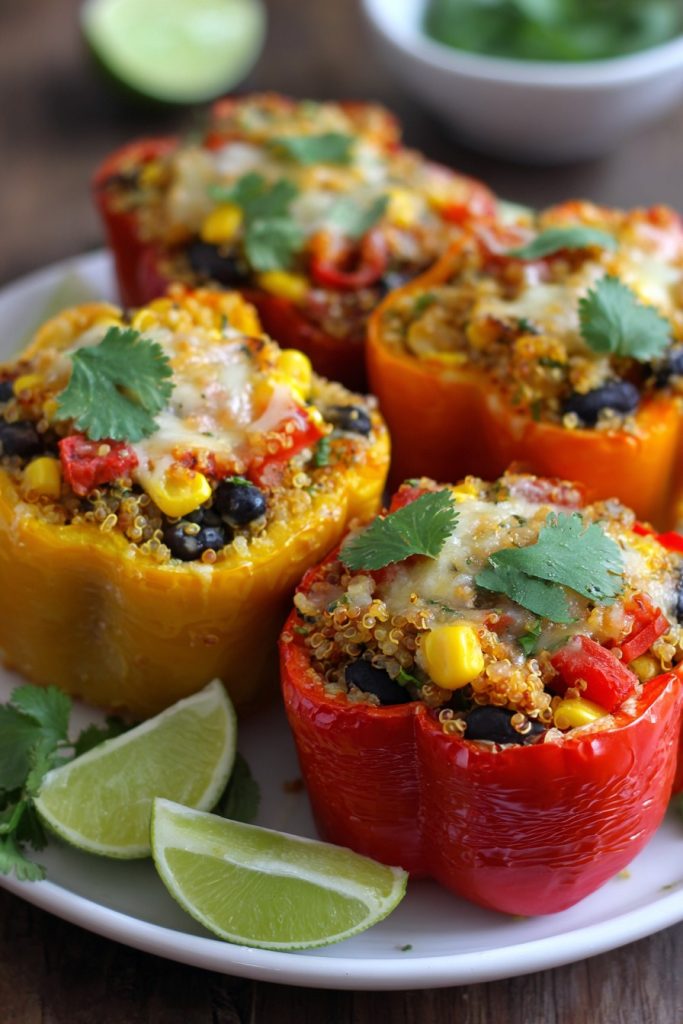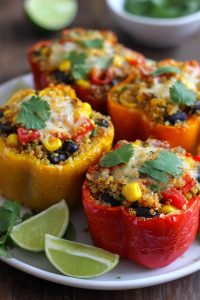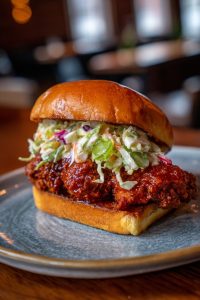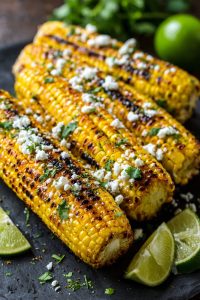Creating vibrant, nutrient-dense meals that satisfy both taste buds and nutritional needs can transform your approach to healthy eating. Colorful bell peppers become edible vessels for a savory quinoa mixture that delivers complete protein, fiber, and essential vitamins in every bite. This recipe exemplifies how whole foods can create meals that are as nourishing as they are delicious.
Why This Recipe Works
- The combination of quinoa and black beans creates a complete protein profile, providing all nine essential amino acids that support muscle repair, immune function, and sustained energy levels throughout your day.
- Bell peppers serve as natural edible containers that retain moisture during baking while contributing significant amounts of vitamins A and C, both crucial antioxidants that support vision health and immune system function.
- Using vegetable broth instead of water to cook the quinoa infuses the grain with deeper savory flavors while adding minerals and nutrients that water alone cannot provide.
- The strategic layering of spices including cumin and smoked paprika creates complex flavor profiles without relying on excessive sodium or artificial flavor enhancers.
- Baking at 375°F ensures the peppers become tender without becoming mushy while allowing the filling to develop a slightly crisp top layer for textural contrast.
Ingredients
- 4 large bell peppers (mixed colors recommended), tops removed and seeds discarded
- 1 cup uncooked quinoa, rinsed thoroughly under cold water
- 2 cups low-sodium vegetable broth
- 1 medium yellow onion, finely diced
- 3 cloves garlic, minced
- 1 can (15 ounces) black beans, rinsed and drained
- 1 cup frozen corn kernels, thawed
- 1 can (14.5 ounces) diced tomatoes, undrained
- 2 tablespoons olive oil
- 1 teaspoon ground cumin
- 1 teaspoon smoked paprika
- 1/2 teaspoon chili powder
- 1/4 teaspoon black pepper
- 1 cup shredded Monterey Jack cheese, divided
- 1/4 cup fresh cilantro, chopped
- 1 lime, cut into wedges for serving
Equipment Needed
- Medium saucepan with lid
- Large skillet
- 9×13 inch baking dish
- Cutting board and chef’s knife
- Measuring cups and spoons
- Mixing bowls
- Aluminum foil
Instructions
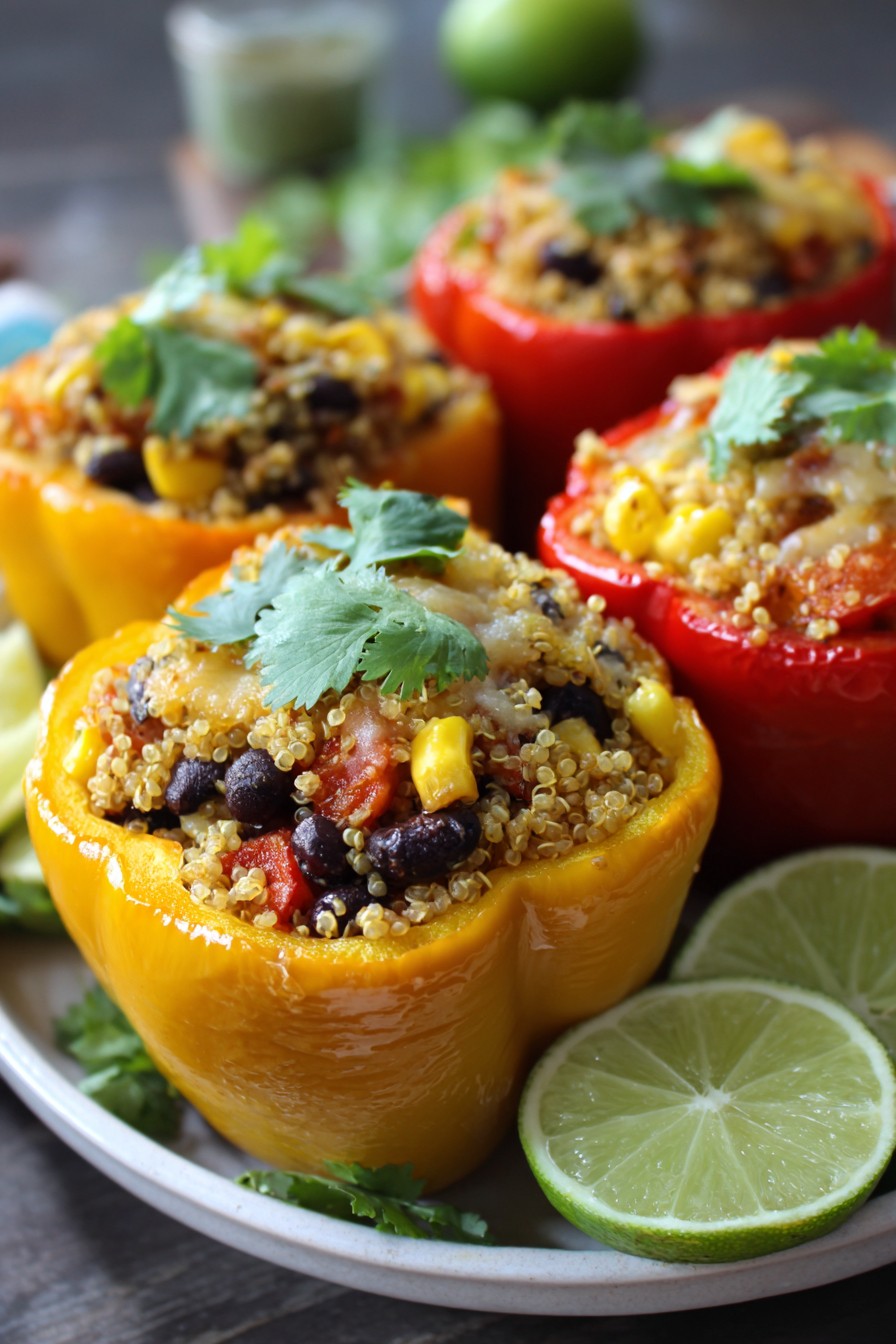
Prepare the Quinoa Base
Begin by thoroughly rinsing 1 cup of uncooked quinoa under cold running water using a fine-mesh strainer for approximately two minutes, which removes the natural saponin coating that can impart bitterness. Combine the rinsed quinoa with 2 cups of low-sodium vegetable broth in a medium saucepan, bringing the mixture to a vigorous boil over high heat before immediately reducing to the lowest simmer setting and covering with a tight-fitting lid. Cook undisturbed for exactly 15 minutes, then remove from heat and let stand covered for an additional 5 minutes to allow the grains to fully absorb any remaining liquid and become fluffy. This cooking method ensures each quinoa grain remains separate and perfectly textured rather than becoming mushy or clumped together. Fluff the cooked quinoa with a fork to aerate the grains before incorporating into the filling mixture. Tip: For enhanced flavor absorption, consider warming the vegetable broth before adding the quinoa rather than starting with cold liquid.
Sauté the Aromatics and Vegetables
Heat 2 tablespoons of olive oil in a large skillet over medium heat until shimmering but not smoking, approximately 90 seconds. Add 1 finely diced medium yellow onion and cook while stirring frequently until translucent and slightly golden around the edges, about 6-8 minutes, being careful not to let the onion brown too quickly. Introduce 3 minced garlic cloves and continue cooking for another 60 seconds until fragrant but not burned, as burnt garlic develops bitter compounds that can overwhelm the dish’s delicate flavor balance. Incorporate 1 teaspoon ground cumin, 1 teaspoon smoked paprika, 1/2 teaspoon chili powder, and 1/4 teaspoon black pepper, toasting the spices for 30 seconds until their essential oils release and create an aromatic foundation. This spice-toasting technique deepens flavor complexity without requiring additional salt or fat. Add 1 cup thawed frozen corn kernels and cook for 2 minutes until slightly caramelized, enhancing their natural sweetness.
Combine the Filling Ingredients
Transfer the cooked quinoa to the skillet with the sautéed vegetable mixture, using a wooden spoon to combine thoroughly while scraping any browned bits from the pan bottom. Add 1 can of rinsed and drained black beans, 1 undrained can of diced tomatoes, and 3/4 cup of shredded Monterey Jack cheese, reserving the remaining 1/4 cup for topping. The tomato liquid provides necessary moisture while contributing lycopene, a powerful antioxidant that becomes more bioavailable when cooked. Stir in 1/4 cup of freshly chopped cilantro, reserving a small amount for garnish, and mix until all components are evenly distributed. Taste the mixture and adjust seasoning if desired, though the natural flavors from the vegetables, spices, and cheese typically provide sufficient seasoning. The filling should hold together when pressed but not be overly wet. Tip: For optimal texture, allow the filling to cool slightly before stuffing the peppers to prevent the peppers from becoming too soft during baking.
Stuff and Arrange the Peppers
Select 4 large bell peppers that can stand upright independently, slicing approximately 1/2 inch from the top and carefully removing the seeds and white membranes while preserving the pepper’s structural integrity. Lightly salt the interior of each pepper to enhance their natural flavors, then firmly pack the quinoa filling mixture into each cavity, mounding slightly above the rim as the filling will settle during baking. Arrange the stuffed peppers in a 9×13 inch baking dish that has been lightly coated with olive oil or cooking spray to prevent sticking. If any peppers wobble, create a stable base by slicing a thin piece from the bottom, being careful not to cut through to the filling compartment. Pour 1/4 cup of water or additional vegetable broth into the bottom of the baking dish around the peppers to create steam that helps cook the peppers evenly and prevents drying.
Bake to Perfection
Preheat your oven to 375°F and position the rack in the center for even heat distribution. Cover the baking dish tightly with aluminum foil, creating a sealed environment that traps steam and ensures the peppers become tender without burning the filling. Bake covered for 30 minutes, then carefully remove the foil and sprinkle the remaining 1/4 cup of shredded Monterey Jack cheese evenly over the top of each pepper. Return to the oven uncovered and continue baking for an additional 10-15 minutes until the cheese is completely melted and lightly golden, and the pepper exteriors are tender enough to easily pierce with a fork but still maintain their structural integrity. The filling should reach an internal temperature of 165°F when tested with an instant-read thermometer. Tip: For a crispier topping, switch to broil for the final 2-3 minutes, watching carefully to prevent burning.
Rest and Serve
Remove the baking dish from the oven and transfer the stuffed peppers to a wire cooling rack, allowing them to rest for 8-10 minutes before serving. This resting period allows the filling to set slightly, making the peppers easier to handle and cut while allowing the flavors to fully integrate. The internal temperature will continue to rise slightly during this time, reaching the optimal serving temperature of 170-175°F. Garnish with remaining fresh cilantro and serve with lime wedges for squeezing over the top, which adds bright acidity that balances the rich, savory flavors. The acid from the lime also enhances iron absorption from the quinoa and beans. Each pepper makes a complete meal, though they pair beautifully with a simple green salad or roasted vegetables for additional nutrient diversity.
Tips and Tricks
Selecting the right peppers significantly impacts your final result. Choose bell peppers that are firm with taut, glossy skin and feel heavy for their size, indicating optimal moisture content. Peppers with four distinct lobes at the bottom tend to stand more steadily and provide more stuffing space than those with three lobes. For even cooking, try to select peppers of similar size and shape. When preparing the peppers, use a sharp paring knife to carefully remove the tops and inner membranes, preserving as much of the pepper’s structure as possible. If your peppers won’t stand upright, create a stable base by slicing a very thin piece from the bottom, being cautious not to cut through to the cavity. For extra flavor infusion, consider rubbing the outside of the peppers lightly with olive oil and sprinkling with a pinch of salt before baking. This enhances the pepper’s natural sweetness as it roasts. When making the quinoa, proper rinsing is non-negotiable—quinoa naturally contains saponins, bitter compounds that can negatively impact flavor if not thoroughly removed. Use a fine-mesh strainer and cold running water, agitating the grains with your fingers until the water runs completely clear. For those monitoring sodium intake, choose no-salt-added canned goods and low-sodium vegetable broth, then adjust seasoning at the end if needed. The filling can be prepared up to two days in advance and stored separately from the peppers in an airtight container in the refrigerator. This not only saves time but allows the flavors to meld more completely. When ready to assemble, bring the filling to room temperature before stuffing the peppers to ensure even baking. For meal prep purposes, these stuffed peppers freeze exceptionally well. Cool completely after baking, wrap individually in plastic wrap, then place in freezer bags for up to three months. Reheat directly from frozen in a 350°F oven for 25-30 minutes until heated through. If you prefer crispier toppings, consider adding crushed tortilla chips or breadcrumbs mixed with a tablespoon of nutritional yeast to the cheese topping for added texture and flavor complexity.
Recipe Variations
- For a Mexican-inspired twist, incorporate 1 teaspoon of chili powder, 1/2 teaspoon of oregano, and replace the black beans with pinto beans. Add 1/4 cup of chopped green chilies and top with pepper Jack cheese instead of Monterey Jack for additional spice. Serve with avocado slices and a dollop of Greek yogurt instead of sour cream for reduced fat content while maintaining creaminess. This variation increases the capsaicin content, which may boost metabolism and provide anti-inflammatory benefits.
- Create a Mediterranean version by substituting the black beans with chickpeas and adding 1/2 cup of chopped Kalamata olives, 1/4 cup of crumbled feta cheese, and 2 tablespoons of chopped fresh oregano. Replace the cumin and paprika with 1 teaspoon of dried oregano and 1/2 teaspoon of lemon zest. The briny olives and tangy feta provide sodium naturally, reducing the need for additional salt while offering healthy monounsaturated fats from the olives.
- For a protein-packed breakfast option, use sausage-seasoned turkey or plant-based crumbles instead of beans, and add 1/2 cup of diced sweet potato that has been roasted until tender. Incorporate 1 teaspoon of sage and 1/2 teaspoon of thyme, then top with a sprinkle of sharp cheddar cheese. The sweet potatoes provide complex carbohydrates for sustained morning energy while adding vitamin A and fiber to support digestive health throughout the day.
- Transform into a Thai-inspired creation by using coconut milk instead of vegetable broth to cook the quinoa, and adding 1 tablespoon of red curry paste, 1/4 cup of chopped peanuts, and 1/4 cup of fresh basil. Replace the black beans with edamame for additional protein and top with a drizzle of peanut sauce instead of cheese. The coconut milk provides medium-chain triglycerides that are easily utilized for energy, while curry spices like turmeric offer anti-inflammatory compounds.
Frequently Asked Questions
Can I make these quinoa stuffed peppers ahead of time?
Absolutely, these stuffed peppers are excellent for meal preparation. You can prepare the filling up to three days in advance and store it separately from the peppers in airtight containers in the refrigerator. When ready to bake, simply stuff the peppers and proceed with the baking instructions, though you may need to add 5-10 minutes to the baking time since you’re starting with cold filling. For even more convenience, you can fully assemble the peppers and refrigerate them covered for up to 24 hours before baking. The flavors actually improve with this resting period as the ingredients have more time to meld together. If baking directly from refrigeration, add approximately 10-15 minutes to the covered baking time to ensure the centers reach the proper temperature.
What’s the best way to reheat leftover stuffed peppers?
For optimal texture and flavor preservation, reheating in the oven or toaster oven is superior to microwave reheating. Preheat your oven to 350°F and place the peppers in an oven-safe dish with a tablespoon of water or broth added to the bottom to create steam. Cover with foil and heat for 15-20 minutes until warmed through, then remove the foil for the last 5 minutes to restore any crispness to the topping. If using a microwave, place the pepper on a microwave-safe plate and cover loosely with a damp paper towel to help distribute heat evenly and prevent drying. Heat on medium power for 2-3 minutes, checking and rotating halfway through. The microwave method is quicker but may result in slightly softer pepper walls.
Can I use different grains instead of quinoa?
Certainly, while quinoa provides complete protein and valuable nutrients, other whole grains can work beautifully in this recipe. Brown rice offers similar fiber content and requires cooking in vegetable broth before incorporating into the filling, though it needs approximately 40-45 minutes cooking time. Farro provides a chewy texture and nutty flavor while delivering fiber and protein, though it benefits from pre-cooking as well. For lower-carb options, cauliflower rice can be substituted—simply sauté it with the aromatics until tender rather than cooking separately. When substituting grains, maintain the same volume measurements but adjust liquid amounts and cooking times according to each grain’s specific requirements. Each grain brings unique nutritional profiles, so consider your dietary needs when selecting alternatives.
How can I make this recipe vegan?
Creating a vegan version is straightforward and equally delicious. Simply omit the Monterey Jack cheese or replace it with your favorite plant-based cheese alternative. For enhanced flavor without dairy, consider adding 2 tablespoons of nutritional yeast to the filling mixture, which provides a cheesy flavor while adding B vitamins. Another option is to create a cashew cream topping by blending 1/2 cup of soaked cashews with 1/4 cup of water, 1 tablespoon of lemon juice, and 1/2 teaspoon of garlic powder until smooth, then dolloping this over the peppers before the final baking stage. The black beans and quinoa already provide complete protein, so no additional protein sources are necessary for nutritional adequacy.
Are there low-carb alternatives to bell peppers for this filling?
Yes, several vegetable vessels work well for those monitoring carbohydrate intake. Large portobello mushroom caps provide a meaty texture and umami flavor while being significantly lower in carbohydrates—simply remove the stems and scrape out the gills before stuffing. Zucchini boats created by halving large zucchini lengthwise and scooping out the center seeds also work beautifully, though they require reduced baking time of approximately 20-25 minutes total. For even lower carbohydrate content, cabbage leaves can be blanched until pliable, then filled and rolled similar to stuffed cabbage, baking for 30-35 minutes until tender. Each alternative provides different nutrient profiles, with mushrooms offering selenium and B vitamins, zucchini providing potassium, and cabbage delivering vitamin K and antioxidants.
Summary
These quinoa stuffed peppers deliver complete nutrition in every vibrant bite, combining plant-based proteins, fiber-rich vegetables, and wholesome grains. The versatile recipe adapts to various dietary preferences while maintaining exceptional flavor and nutritional integrity. Perfect for meal preparation and family dinners alike, this dish exemplifies how healthy eating can be both satisfying and delicious.
